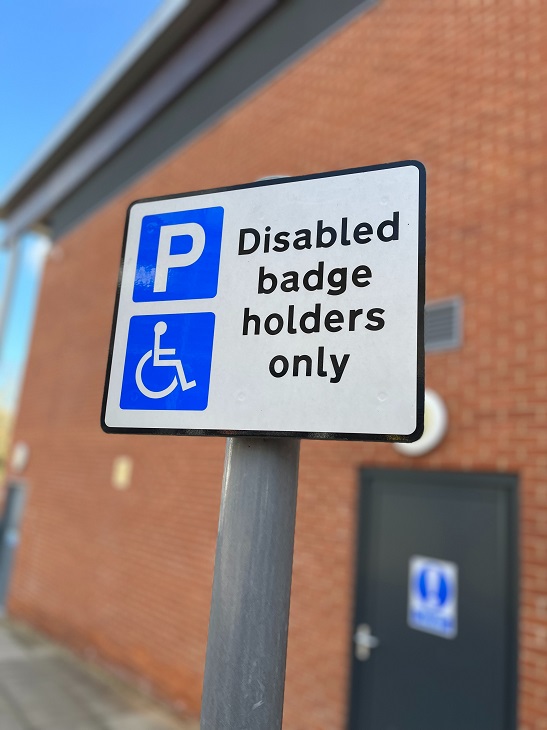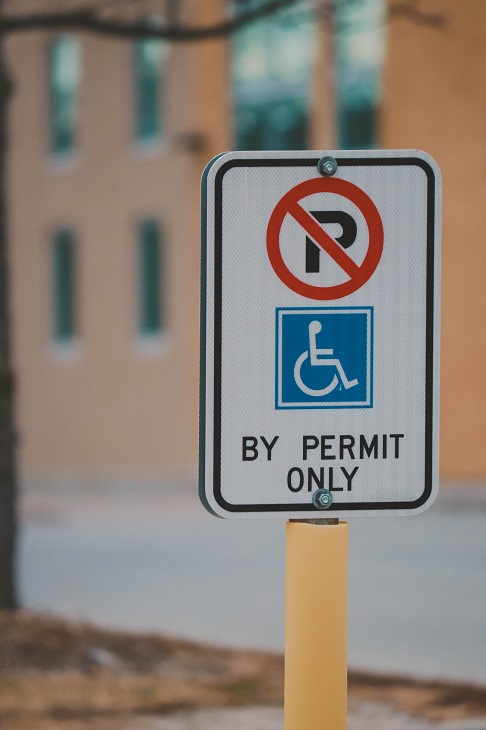As society progresses and technology continues to evolve, the need for innovative and inclusive urban design becomes more apparent. One area that requires immediate attention is the improvement of disabled parking solutions. Accessible parking is not just a matter of convenience but an essential component of ensuring equal opportunities for all members of society. Today we’ll be exploring some futuristic perspectives on disabled parking solutions in the United States, addressing the challenges faced today and proposing visionary ideas for a more inclusive and accessible future. From handicap parking laws in North Dakota to Ohio handicap parking regulations, we’re taking a look at what the future might look like for disabled parking across the country!
The Current Landscape of Disabled Parking
Before delving into the future, it’s crucial to understand the current state of disabled parking in the US. While the Americans with Disabilities Act (ADA) mandates the provision of accessible parking spaces, issues persist. Many parking lots have inadequate spaces, and enforcement of parking violations is inconsistent. Furthermore, the traditional blue-and-white accessible parking symbol may not be universally understood, leading to misuse of these spaces.
Another challenge is the physical accessibility of parking spaces. For individuals with mobility issues, getting in and out of a vehicle can be a daunting task. The current design of accessible parking spaces often lacks features like wider spaces, adjacent access aisles, and appropriate ramp gradients, making it difficult for wheelchair users and those with mobility aids to navigate comfortably.
Finally, something that may cause challenges in the current disabled parking landscape is the inconsistency across all 50 states. Many laws, regulations, and processes differ across states – Nebraska handicap parking requirements are different from Texas disabled parking laws; North Carolina handicap parking rules differ from California handicap parking regulations; the process for Tennessee handicap parking permit renewal differs from Wisconsin handicap parking permit renewal; and so on. This may be an important element to consider in looking to the future of disabled parking in the United States.
Futuristic Design Principles
In envisioning tomorrow’s disabled parking solutions, it’s essential to adopt a holistic approach that considers not only physical accessibility but also incorporates emerging technologies to create a more inclusive environment. Here are some futuristic design principles that can revolutionize disabled parking:
Smart Parking Systems
Imagine a world where parking lots are equipped with smart sensors and artificial intelligence that can dynamically allocate accessible parking spaces based on real-time demand. Smart parking systems can identify available spaces and reserve them for individuals with disabilities, optimizing the utilization of these crucial spots.
Augmented Reality Signage
Traditional signage can be confusing or overlooked. Augmented reality (AR) technology can enhance the visibility and understanding of disabled parking spaces. By using AR apps on smartphones or AR glasses, users can easily identify accessible parking spots, get directions to the nearest one, and receive information about available amenities.
Universal Design and Inclusive Architecture
Future parking structures should be designed with universal accessibility in mind. This involves creating spaces that are not only compliant with ADA standards but go beyond to cater to a diverse range of disabilities. Features such as adjustable ramp gradients, tactile guides, and audio cues can significantly improve the overall accessibility of parking facilities.
Autonomous Vehicles and Drop-Off Zones
The rise of autonomous vehicles presents an exciting opportunity to reimagine disabled parking. Designated drop-off zones equipped with automated valet services can enhance accessibility for individuals with mobility challenges. Autonomous vehicles can drop off passengers at the entrance and then proceed to park themselves in specially designed spaces, ensuring a seamless experience.
Blockchain for Parking Permit Verification
To combat misuse and ensure that only authorized individuals use accessible parking spaces, blockchain technology can be employed for secure and transparent verification of parking permits. This decentralized system would provide a tamper-proof record of permit ownership, reducing the likelihood of fraudulent use.

Overcoming Challenges
While the vision of futuristic disabled parking solutions is inspiring, the road to implementation is fraught with challenges. As we envision a future where technology and inclusive design transform the parking landscape for individuals with disabilities, several obstacles must be overcome to ensure the success of these innovations.
1. Financial Constraints
One of the primary challenges in implementing futuristic disabled parking solutions is the financial burden associated with adopting new technologies and redesigning existing infrastructure. Many municipalities and private entities may find it challenging to allocate sufficient funds to upgrade parking facilities with smart sensors, augmented reality signage, and other high-tech solutions.
The installation of smart parking systems, for example, requires a significant upfront investment. The cost of retrofitting existing parking structures or integrating new technologies into urban planning may be prohibitive for some communities, leading to slow or incomplete adoption of these futuristic solutions. Addressing financial constraints requires a strategic approach that combines public and private investment, government grants, and incentives for businesses to embrace accessible parking upgrades.
2. Resistance to Change
Resistance to change is a pervasive issue in any societal transformation, and the implementation of futuristic disabled parking solutions is no exception. Stakeholders involved in urban planning, parking management, and the general public may resist adopting new technologies or altering familiar parking practices. This resistance can stem from concerns about the unknown, fear of job displacement in traditional parking management roles, or a general reluctance to deviate from established norms.
Overcoming resistance to change requires comprehensive education and awareness campaigns. Stakeholders need to understand the long-term benefits of futuristic parking solutions, both in terms of improved accessibility for individuals with disabilities and the overall efficiency of parking systems. Involving local communities in the decision-making process and addressing concerns transparently can help build support for the necessary changes.
3. Need for Widespread Adoption
For futuristic disabled parking solutions to be truly effective, they must be widely adopted across cities and communities. Achieving widespread adoption is a complex challenge that involves coordination between various entities, including government agencies, private businesses, and technology providers. Inconsistent implementation can lead to fragmented accessibility, where certain areas boast cutting-edge solutions while others lag behind.
The need for widespread adoption also ties into standardization. Ensuring that emerging technologies adhere to common standards facilitates interoperability and simplifies the implementation process. Governments and industry organizations play a crucial role in establishing and promoting these standards, creating a cohesive framework for the integration of futuristic disabled parking solutions nationwide.
4. Inclusive Design Considerations
Futuristic disabled parking solutions must prioritize inclusivity in their design. While technological advancements can greatly enhance accessibility, it is essential to consider the diverse range of disabilities and ensure that solutions cater to the specific needs of different user groups. This involves addressing challenges such as cognitive impairments, sensory disabilities, and varying levels of mobility.
Inclusive design also requires ongoing consultation with individuals with disabilities to gather insights into their experiences and preferences. By actively involving the disabled community in the design and testing phases, developers can create solutions that genuinely meet the diverse needs of the user base.
Overcoming the above challenges will require collaboration, education, and a commitment to inclusivity to ensure that these challenges are addressed, paving the way for a more accessible and equitable future for all.
Benefits of Futuristic Disabled Parking Solutions
The benefits of futuristic disabled parking solutions extend far beyond the realm of convenience; they represent a transformative leap toward creating a more inclusive and accessible urban environment. As technology continues to evolve, so does the potential to revolutionize the way individuals with disabilities experience parking facilities. From smart parking systems that optimize space utilization to augmented reality signage that enhances visibility, these innovations promise to improve efficiency, reduce misuse, and foster a culture of social inclusivity.
Here are some of the benefits of futuristic disabled parking solutions:
- Enhanced Accessibility: The primary goal of futuristic disabled parking solutions is to enhance accessibility. By leveraging technology and innovative design, these solutions can create a more inclusive environment for individuals with disabilities.
- Improved Efficiency: Smart parking systems and autonomous vehicles can optimize the use of accessible spaces, ensuring that they are available when needed. This efficiency benefits both individuals with disabilities and the general public by reducing congestion and improving overall parking management.
- Social Inclusivity: By embracing universal design principles and leveraging technology, society can foster a culture of inclusivity. This not only benefits individuals with disabilities but contributes to a more compassionate and understanding community at large.
- Reduced Misuse and Fraud: Blockchain-based verification systems can significantly reduce the misuse of disabled parking spaces. A transparent and secure permit validation process ensures that only those who genuinely need accessible parking can avail of these facilities.
***
The future of disabled parking in the United States holds immense potential for positive transformation. By combining innovative technology with inclusive design principles, we can create a tomorrow where accessibility is not a challenge but a fundamental aspect of urban planning. It is crucial for policymakers, urban designers, and technology experts to collaborate and envision a future where disabled parking is not just a regulatory requirement but a reflection of a society that values and prioritizes the needs of all its members. Through forward-thinking solutions, we can design tomorrow’s spaces today, ensuring a more accessible and inclusive world for generations to come.
For more info on everything from Arizona handicap parking permit application to Virginia handicap parking permit application and everything in between, check out the Dr Handicap website!
Featured image by Michael Fousert on Unsplash




